Nov 29, 2013 | celebration, coins, US Mint
 As we welcome Black Friday and the holiday shopping season, the U.S. Mint is getting into the act by bringing back Free Standard Shipping. Buy whatever your want from the U.S. Mint online catalog and get free standard shipping until December 6, 2013.
As we welcome Black Friday and the holiday shopping season, the U.S. Mint is getting into the act by bringing back Free Standard Shipping. Buy whatever your want from the U.S. Mint online catalog and get free standard shipping until December 6, 2013.
According to sources, the free shipping promotion in September went very well bringing increased sales volume to the U.S. Mint. Since shipping and packaging are the few aspects that the U.S. Mint can control on its own, they are going to use whatever it takes to get noticed to bring collectors and gift buyers to their site.
They got me. I am going to be ordering my 2013 Presidential Dollar First Day Covers with the free shipping. I have to keep my collection up to date!
Unfortunately, the Teddy Roosevelt Coins and Chronicles set will not be released until December 17, after the free shipping sale.
Nov 28, 2013 | celebration, history, other

American Abundance designed by Albert Laessle and issued in 1934
After arriving in the New World in 1620, the Pilgrims celebrated their first harvest in 1621. The three-day even was attended by 53 Pilgrims and 90 Native Americans that lasted three days. The tradition of giving thanks for successes was a tradition that the Pilgrims brought with them from England. This three-day celebration in 1621 is considered the first Thanksgiving.
Thanksgiving was celebrated during many different times within the colonies, mainly to give thanks for something that was honorable to the colony or the locality that observed the celebration. The first national recognition of a Thanksgiving celebration came when General George Washington declared December 1777 as Thanksgiving honoring the defeat of the British at Saratoga. As President, George Washington declared the first national Thanksgiving celebration on November 26, 1789. The only other president to issue a Thanksgiving proclamation was President James Madison. From then, it was up to the individual states to declare a Thanksgiving holiday.
As part of his attempt to maintain the union, President Abraham Lincoln issued a proclamation that made Thanksgiving Day a national annual event on the last Thursday in November beginning in 1863.
Thanksgiving remained the last Thursday of November until 1939 when he declared Thanksgiving to be on the fourth Thursday of the month to give merchants more time to sell good during the Christmas shopping season. Congress passed a joint resolution in 1942 fixing Thanksgiving to the fourth Thursday of November.
In 1947, the National Turkey Federation has provided the President of the United State with one live turkey and two dressed turkeys. President Harry Truman is credited with pardoning the first turkey in 1947 but it did not become a tradition until President Ronald Reagan started in 1987 and continued by President George H.W. Bush in 1989. Since 1989, the pardoned turkeys have lived the rest of their lives at Frying Pan Park in Herndon, Virginia. Those pardoned by President Obama have gone to live at George and Martha’s old place in Mount Vernon, Virginia.
Happy Thanksgiving!
Medal image courtesy of the Smithsonian Institute.
Nov 25, 2013 | bullion, coins, commemorative, Eagles, poll, US Mint
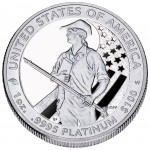
2012 American Eagle Platinum Proof reverse “To Provide for the Common Defence”
Let’s pretend that the Citizens Coinage Advisory Committee could bypass congress (very wishful thinking!), Citizens Coinage Advisory Committee, and the U.S. Commission of Fine Arts to build a portfolio of non-circulating legal tender commemoratives to increase collector sales. Today’s poll, which will run for two weeks, asks what the U.S. Mint should do with its pretend freedom.

Loading ...
For the record, I am in favor of allowing the U.S. Mint to increase the offerings under the American Eagle program. The U.S. Mint has done some of that to this point with the enhanced reverse uncirculated coins and special sets. There should be more special offerings or different offerings. The U.S. Mint could change the reverse designs to honor different themes like they have been doing on the reverse of the platinum American Eagle coins.
I would also like to see more of the enhanced uncirculated American Silver Eagle coins. The way it enhanced Adolph Weinman’s Walking Liberty design makes it a great looking collectible.
Nov 24, 2013 | coin design, commentary, foreign, other, US Mint
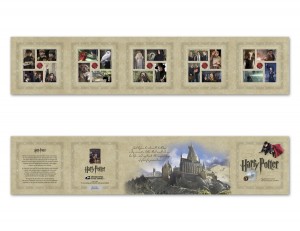 A story appeared in the November 18, 2013 edition of The Washington Post that the hard-core stamp collectors, the ones that will buy the products released by the United States Postal Service, are apoplectic about selection of Harry Potter as a subject for a series of stamps.
A story appeared in the November 18, 2013 edition of The Washington Post that the hard-core stamp collectors, the ones that will buy the products released by the United States Postal Service, are apoplectic about selection of Harry Potter as a subject for a series of stamps.
The objections are two-fold. First, Harry Potter is not American and neither is the author of the series J.K. Rowling. The other reason is that the Postal Service bypassed the Citizens’ Stamp Advisory Committee (CSAC) to make the deal with the various commercial concerns to issue the 20-stamp tribute to the boy wizard.
Unlike the Citizens Coinage Advisory Committee, the CSAC is not mandated by law. It was established in 1957 “to select subjects of broad national interest for recommendation to the Postmaster General that is both interesting and educational.” Apparently, there has been tension between the Postal Service and the CSAC.
Like coin collecting, stamp collecting has been in decline as the awareness and usage of their product declines. Coin collectors can point to the decline in coin collecting following the big start of the 50 State Quarters® program, stamp collectors can point to the growth of email, e-publishing, and electronic stamp capabilities as part of the decline of the postal service. The Postal Service feels it has to do something in order to bring new collectors to buy its goods.

The US Postal Service pays tribute to their own famous error, the Inverted Jenny
The Postal Service has been an independent agency of the federal government since 1971. Their operating expenses largely come from the sale of postage and the collection of duties for cross-border movement of the mail. Other revenues are generated from the sales of collectibles including special sets, first-day covers, and other collectibles. Interesting items sell well including the Elvis Presley stamps which were the Postal Service’s bestseller.
One area of regulation that has hurt the Postal Service was a law passed in 2005 that forced the agency to pre-pay retirement benefits for the next 75-years in a series of very large lump-sum payments. Their inability to meet the obligation and maintain the 75-year cushion has been widely reported causing the agency to lose significant revenues while trying to adhere to this ridiculous statutory requirement. No other agency or company is required to pre-pay 75-years of retirement benefits.
Knowing that they have to generate new revenues, Postmaster General Patrick R. Donahoe was quoted as saying that the Postal Service “needs to change its focus toward stamps that are more commercial.”
In other words, Donahoe recognizes that the organization he leads has to think differently in order to attract new customers.
The reaction from the philately community is almost the same as I would expect from the numismatic community if this was done by the United States Mint.

New Zealand Mint produces Monopoly coins for the Island nation of Niue. Did you pass Go?
Next year, the U.S. Mint will issue a curved coin to honor the National Baseball Hall of Fame. While it will be a round coin, the coin will be concave when looking at its obverse. While the closest thing to “different” the U.S. Mint has produced was the 2009 Ultra High Relief Gold Coin, the sales of the Baseball Hall of Fame Commemorative coins may do well because of the theme and they are different.

2007 Somalia Motorcycle Non-circulating Legal Tender Coins
“Harry Potter is not American. It’s foreign, and it’s so blatantly commercial it’s off the charts,” said John Hotchner who was once president of the American Philatelic Society and served on the CSAC for 12 years. Hotchner should be asked about the stamps to commemorate Pixar animation, Disney, and muscle cars. Even though I am a coin collector, I have bought the muscle car commemorative panel along with sheets of motorcycle stamps and a collector book with the stamp of Edgar Allen Poe because I was interested in the theme.
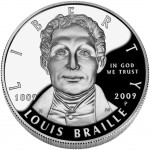
Louis Braille was not American nor did he do his work in America, but congress authorized a commemorative issued in 2009
Coin and stamp collectors have to take their heads out of the past. Stamps are losing to email and coins are losing to credit cards. Neither are going away anytime soon, but if there is to be a future both the U.S. Mint and U.S. Postal Service has to be innovative in order to attract new collectors. While the U.S. Mint is handcuffed by the whims of a dysfunctional congress, the Postal Service can capitalize on one of the most popular books and stories of this generation. If it helps promote stamp collecting and allows them to sell more products, then the Postmaster General should be congratulated for a job well done.
Maybe there is something that can be done to add to the catalog of the U.S. Mint in order to generate more interest. Until then, this muggle will be ordering something from the Harry Potter collectibles offered by the Postal Service for his wife who is a Harry Potter fanatic!
What do you think? Weigh in on the discussion in the comments (below).
Credits
- All stamp images courtesy of the United States Postal Service.
- Monopoly coin image courtesy of the New Zealand Mint.
- Louis Braille Commemorative image courtesy of the U.S. Mint.
- Somalia motorcycle coin images are courtesy of the author.
Nov 22, 2013 | coins, halves, history, US Mint
It was the modern day “Shot heard ’round the world.” At 12:30 PM Central Time, while the motorcade carrying President John F. Kennedy, First Lady Jacqueline Kennedy, Texas Governor John Connally, and Connally’s wife Nellie was twice fired upon while passing through Dealey Plaza in Dallas. Lee Harvey Oswald fired two shots from the Texas School Book Repository at the convertible. The first shot hit the President under his arm which was held up as he waved at the crowd. The bullet passed through his body and struck Governor Connally. The second bullet struck the President in the head.
At 1:00 PM, President John Fitzgerald Kennedy was pronounced dead at Parkland Hospital.
Vice President Lyndon B. Johnson refused to leave Dallas for Washington without the Jacqueline Kennedy or the body of the president. At 2:38 PM, Johnson took the oath of office aboard Air Force One with Mrs. Kennedy at his side. She wore the blood-splattered coat to remind people of the tragedy that just occurred.
Fifty years later, those who experienced the assassination as part of the American family continues to remember the sadness and grieving by everyone, even those that did not support Kennedy. Some have described the feeling as more profound than what we experienced on September 11, 2001 because while both were tragedies, Kennedy was the living symbol of a bright future.
“We choose to go to the Moon in this decade and do the other things, not because they are easy, but because they are hard.”
—John F. Kennedy
Sept. 12, 1962
Kennedy became the youngest person to ever be elected as President and the first Roman Catholic. At 43, Kennedy was the promise of a new vision that would have the United States leading the world in fighting the “common enemies of man: tyranny, poverty, disease, and war itself.” In his inaugural address, he called the nation to arms for its own sake when he said, “Ask not what your country can do for you, ask what you can do for your country.”
Kennedy made an impact on this country in such a short period of time that one can wonder what would have happened if….
 A few days after Kennedy’s assassination on November 22, 1963, U.S. Mint Director Eva Adams, Chief Engraver Gilroy Roberts reported that there was discussions about putting Kennedy’s portrait on a silver coin. Since Jacqueline Kennedy did not want to replace Washington’s portrait on the quarter, it was decided to use the half-dollar. Roberts used models from the inaugural medal for the obverse design and Assistant Engraver Frank Gasparro prepared the reverse design using the Presidential Seal.
A few days after Kennedy’s assassination on November 22, 1963, U.S. Mint Director Eva Adams, Chief Engraver Gilroy Roberts reported that there was discussions about putting Kennedy’s portrait on a silver coin. Since Jacqueline Kennedy did not want to replace Washington’s portrait on the quarter, it was decided to use the half-dollar. Roberts used models from the inaugural medal for the obverse design and Assistant Engraver Frank Gasparro prepared the reverse design using the Presidential Seal.
Since the law stated that coinage design could not be changed more often than 25 years, and that the Franklin Half was only 15 years old, it required Congress to authorize the change. The Act of December 30, 1963 allowed the design to be changed.
When the coin was released in 1964, the 90-percent silver coin was saved by a grieving nation wanting something that represented the fallen President. Over 273 million coins were struck in Philadelphia and 156 million in Denver. The composition was changed in 1965 with the introduction of clad coinage. Half-dollars consisted of 40-percent silver that included a core made from 79-percent copper and 21-percent silver. In 1971, the composition was changed to current copper-nickel clad that is in use today.
 There has been one design change to the coin and that occurred in 1975 and 1976 in honor of the American Revolution Bicentennial. A special reverse depicting Independence Hall in Philadelphia was designed by Seth G. Huntington. For both years, the obverse featured the dual date 1776-1976 in celebration.
There has been one design change to the coin and that occurred in 1975 and 1976 in honor of the American Revolution Bicentennial. A special reverse depicting Independence Hall in Philadelphia was designed by Seth G. Huntington. For both years, the obverse featured the dual date 1776-1976 in celebration.
On the 50th anniversary of his assassination, we salute President John Fitzgerald Kennedy for his service and mourn the loss to this country.
Nov 20, 2013 | advice, coin design, commemorative, legislative, policy, US Mint
As a comment on my post about the selection design for my 2014 Baseball Hall of Fame Commemorative coin a reader commented with a simple question: Can you offer a suggestion as to who I can approach to offer an idea for a commemorative dollar?
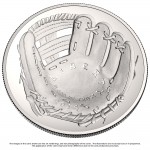
National Baseball Hall of Fame Commemorative was introduced by Rep. Richard Hanna (R-NY) whose district includes Cooperstown, NY
While I cannot fix the fractious nature of congress, I can offer suggestions as to how to get a commemorative coin recognized as a good idea.
As you read this post, let me remind you that former German Chancellor Otto von Bismarck once said, “Laws are like sausages, it is better not to see them being made.” What follows is a look into what it takes to make the sausage in order to propose a commemorative coin and have it become law.
First, rather than starting with congress talk with organizations in the area of interest. After all, commemorative coin programs are fundraising vehicles for the organizations. It helps congress know who will receive the money. In this case, my correspondent wants to see a commemorative coin to be issued in 2017 commemorate the 50th anniversary of the first ever heart transplant.
“My hope is to get more people aware of the need of people to sign up for the donor list to make more organs available,” my correspondent writes. “A donor sign up card could be included with each order. Proceeds could fund awareness program….”
The problem is that this is a good and noble idea but the first question a congress person would ask is what organization would receive the money? Unfortunately, congress is not into creative thinking and would like to know who could receive the money, how the money would be used, and what guarantees that the money earned from the commemorative program would be used for its intended purposes.
Do not expect the representative to do all of the work. In fact, do not expect the congress person to do much of the work until the bill is written and submitted. Even though congress will be in session fewer hours this year than in recent recorded memory, the members will tell you they are too busy to work on this issue. The nature of modern politics is that unless you are going to cut them, the party, their political action committee, or one of their other campaign committees a check, your chance for success is diminished.
However, you can cut through the fog of politics by working with a credible non-profit organization—or a coalition of non-profit organizations—with your interest.

I’m just a bill
Yes, I’m only a bill
And I’m sitting here on Capitol Hill
When contacting these people, I would have an elevator-speech ready. An elevator speech is one that pitches your idea in the time it would take to ride an elevator. In other words, keep it short and to the point. Make sure your pitch includes something compelling to want them ask for more information and make sure you anticipate any questions.
The nice part about partnering with the AHA is that they are very experienced with legislative affairs. I have no doubt that they either have a full-time lobbyist on staff or have hired a lobbying firm to represent their interests before congress. This is one area where you do not have to answer questions. However you should know a little about commemorative coin bills that congress has considered. These issues are as follows:
Q: After a commemorative coin bill is introduced, which committee will it be assigned?
Q: How does the organization make money from a commemorative coin?
A: Congress sets a surcharge over and above the cost to produce the coin that will be given to the sponsoring organization. Usually, the surcharges are $35 for gold coins, $10 for silver dollars, and $5 for clad 50-cent coins.
Q: Are limits set for the number of coins sold?
A: There are no pre-set limits unless written into the law. Usually, congress has set the limits to be not more than 100,000 $5 gold coins, 500,000 $1 silver coins, and 750,000 50-cent clad coins. The number of uncirculated versus proof issues is determined by the
U.S. Mint as long as they remain within these limits. Coins are produced and sold by the U.S. Mint only during the year of issue.
Q: Who designs the coins?
Q: How do we request that heart health and transplant awareness be inserted into the coins with the Certificate of Authenticity?
A: Make sure that the information is added to the law. Unless the sponsoring organization can compel the U.S. Mint to add it, you are better off making sure the law requires that the U.S. Mint does this.
Q: Can you give me an example of how one of these bills is written?
A: Most of the time, when you read the bills submitted to congress, you will see text that calls for editing of the law, which is called the United States Code (U.S.C.). It may say to strike words, replace words, add paragraphs, add sections, and all sorts of other editing that does not make sense unless you know what the U.S.C. says when the bill was written.
Since most commemorative coin bills are additions to the law, they are usually added to Title 31, Section 5112 of the United States Code (31 U.S.C. § 5112). Many times, the bill does not mention where the new law will be inserted when it is introduced. It will be corrected before passage.
If you want to provide the member of congress with the text of a bill, which many times is helpful, you may want to use something that has already been introduced as an example to write your own text. Two good examples are as follows:
When visiting the website, look on the right side in the lower half for the link marked “Read Bill Text.”
Both bills specify gold, silver, and clad coins. Your proposal does not have to include all three. In fact, to raise awareness, you might want to consider just a silver dollar and a clad half-dollar.
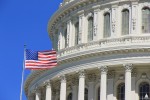
Too bad there’s so much dysfunction in such a beautiful building.
Once you convince a member of congress to submit the bill and get the member’s support, a professional legislative affairs person would know how to convince other members to sign up as co-sponsors. While having a lot of co-sponsors does not guarantee success, it helps with the bill’s awareness and make it more attractive to pass.
There are other political maneuvers that can be used to have the bill passed, such as convincing a member to bring up the bill under a procedure called “suspension of the rules.” In the House of Representatives, a bill brought to a floor vote under the suspension of the rules are usually non-controversial measures that have no objections—or no objections that would be voiced on the floor. The bill would then pass by unanimous consent or a voice vote.
The procedure is similar in the Senate.
Once the bill passes one chamber, it is sent to the other for it to work on passage.

House of Representatives
While the bill is in congress it does not mean you have to sit on your hands and wait. One of the best things you can do is to tell your friends, relatives, and anyone else who will listen to call or email their representative to support the bill. If they are not a co-sponsor, tell their staff that they member should be and why. If they are a co-sponsor, thank them for their support and ask if they could get other members signed on as co-sponsors. If you can find people whose representatives are a member of the House Financial Services Committee or the Senate Banking Committee, then they should modify their support by saying to please help get the bill passed through the committee.

The World’s Most Deliberative Body, the United States Senate
But that does not mean to stop your efforts. Citizen lobbying efforts in the Senate are doubled because each state has two senators. Make sure you and your supporters contact both of your senators. Remember, it is your right as a citizen to meet with your representatives and this includes senators. You can make an appointment to let your senators know how your feel. If your senator is a member of the Senate Banking Committee, then they should be asked to help move the bill out of committee and to the floor for a vote.
The work is not done until the bill is passed or congress is adjourned for the last time on January 2, 2015. Bills not acted upon when congress adjourns for the last time in the session will be considered to have “died in committee.” If the bill dies in committee, you can do this all over again and try to convince a member of congress to submit the bill in the 114th congress that would open its session at noon on January 3, 2015.
If the bill passes both chambers it is likely it will be signed by the president. As far as I know there has never been a commemorative coin bill to have been vetoed by any president.
Although there are a lot of good ideas, many of them are not properly introduced to congress. The few that do make it do not receive enough support to move beyond introduction. Even fewer are passed by one chamber and not both. Those that make it past congress to the president’s desk had some effort behind them besides being just a good idea. After all, with only two commemorative coin programs allowed per year, congress has to be convinced to believe your commemorative idea is better than another for that same year.
Sausage anyone?
Baseball Hall of Fame Commemorative coin courtesy of the
U.S. Mint.
Images of congress and the capitol courtesy of the
Architect of the Capitol.
Image from School House Rock’s “I’m Just a Bill” can be found all over the interwebs.
Nov 19, 2013 | coins, commemorative, history, news
Thursday, November 19, 1863, at the dedication of the Soldier’s National Cemetery in Gettysburg, Pennsylvania, following the the two-hour speech by Edward Everett, President Abraham Lincoln gave short, yet profound address:
Fourscore and seven years ago our fathers brought forth on this continent a new nation, conceived in liberty and dedicated to the proposition that all men are created equal.
Now we are engaged in a great civil war, testing whether that nation or any nation so conceived and so dedicated can long endure. We are met on a great battlefield of that war. We have come to dedicate a portion of that field as a final resting-place for those who here gave their lives that that nation might live. It is altogether fitting and proper that we should do this. But in a larger sense, we cannot dedicate, we cannot consecrate, we cannot hallow this ground. The brave men, living and dead who struggled here have consecrated it far above our poor power to add or detract.
The world will little note nor long remember what we say here, but it can never forget what they did here. It is for us the living rather to be dedicated here to the unfinished work which they who fought here have thus far so nobly advanced. It is rather for us to be here dedicated to the great task remaining before us—that from these honored dead we take increased devotion to that cause for which they gave the last full measure of devotion—that we here highly resolve that these dead shall not have died in vain, that this nation under God shall have a new birth of freedom, and that government of the people, by the people, for the people shall not perish from the earth.

Obverse of the 2009 Abraham Lincoln Commemorative proof coin
Ironically, everyone was not enamored with Lincoln’s brief speech. The Patriot-News of Harrisburg, Pennsylvania did not like the speech. In an editorial published a week after the speech on Tuesday, November 24, 1863, The Patriot-News editorial board added the following paragraph about the ceremony:
We pass over the silly remarks of the President. For the credit of the nation we are willing that the veil of oblivion shall be dropped over them, and that they shall be no more repeated or thought of.
On November 14, 2013, almost 150 years later, The Patriot-News published a retraction to their editorial:
In the editorial about President Abraham Lincoln’s speech delivered Nov. 19, 1863, in Gettysburg, the Patriot & Union failed to recognize its momentous importance, timeless eloquence, and lasting significance. The Patriot-News regrets the error.

Obverse of the 2013-S Lincoln proof cent. Lincoln’s portrait, designed by Victor D. Brenner in 1909, is the longest running design of any United States coin.
Coin images courtesy of the U.S. Mint.
Nov 18, 2013 | coin design, coins, nickels, US Mint

AIP Artist Joe Fitzgerald autographed this 2005 Westward Journey Nickel. They used his design.
Not to take anything away from the U.S. Mint’s sculptor and engravers, the infusion of outside talent does help with design as long as the law authorizing the coin does not handcuff the design process by specifying the design or elements of the design. Left to their own creative abilities, the U.S. Mint and AIP artists have produced some very good designs.
Are you an artist? Do you have what it takes to design coins and medals? Remember, this is paid gig with artists receiving $2000-3000 per submission, depending on years active in the AIP program. Those whose designs are selected to be used on a coin or medal will receive an additional $5000. This is money on top of your other work, so you do not have to quit your day job!
Aside from being paid, your initials will appear on all of the coins produced from your designs and your name will be recorded in numismatic history. In years to come, new collectors will open their reference guides and see the name of the artist who designed their coins. While some artists work are sometimes lost to history, this is one way to make your mark on the world by designing a United States coin.
Do you think you have what it takes? Then read the “CALL FOR ARTISTS” release from the NEA. Application deadline is January 10, 2014. Also note that applications will only be accepted at grants.gov. Make sure you read the “How to Prepare and Submit an Application” information.
If you do submit an application, please let me know. I would be interested in tracking your progress and writing about it for everyone to read.
Nov 12, 2013 | news, personal
The Maryland State Numismatic Association held its annual meeting on Saturday, November 9, 2013 during the Whitman Expo at the Baltimore Convention Center. Following the meeting, the new officers were inaugurated for 2014. Receiving the gavel of the presidency was your favorite coin blogger.
While I would like to say that it was a tough race, I was nominated because I was the previous vice president and elected by a unanimous vote of five people. Truth be told, I forgot to vote! In either case, I accept the honor and trust of the MSNA and hope to expand the organization’s outreach. My first duty will fix the MSNA website that “broke” when my template stopped working properly with the underlining content management system. I hope to fix it by the end of the month.
I do plan to reach out to the member clubs to expand the work of MSNA throughout the state and hopefully grow numismatic participation. We also have a Young Numismatist fund earmarked for a yet to be determined program. If we come up with something good, I will share it with everyone so we can help other numismatic organizations grow.
-
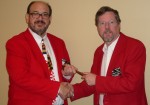
-
2014 President Scott Barman accepts the MSNA gavel from outgoing president Frank Murphy
-

-
2014 MSNA Officers (L-R): Secretary Bryce Doxon, President Scott Barman, Vice President Jack Schadegg, and Treasurer Simcha Kuritzky
If you like my tie (click on one of the images to see a larger version) you can buy your own version on Zazzle. Those who have seen me at the last few show have seen the tie. It gets quite a reaction. If you buy the tie, $5 will be added to the MSNA YN fund I spoke about earlier.
Nov 11, 2013 | celebration, coins, commemorative
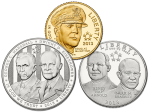
To us in America, the reflections of Armistice Day will be filled with solemn pride in the heroism of those who died in the country’s service and with gratitude for the victory, both because of the thing from which it has freed us and because of the opportunity it has given America to show her sympathy with peace and justice in the councils of the nations.
—U.S. President
Woodrow Wilson proclaiming November 11, 1919 the national holiday Armistice Day
To all that have served…
To all that have given the ultimate sacrifice…
To the families of these honored service members…
THANK YOU!

 As we welcome Black Friday and the holiday shopping season, the U.S. Mint is getting into the act by bringing back Free Standard Shipping. Buy whatever your want from the U.S. Mint online catalog and get free standard shipping until December 6, 2013.
As we welcome Black Friday and the holiday shopping season, the U.S. Mint is getting into the act by bringing back Free Standard Shipping. Buy whatever your want from the U.S. Mint online catalog and get free standard shipping until December 6, 2013.




















